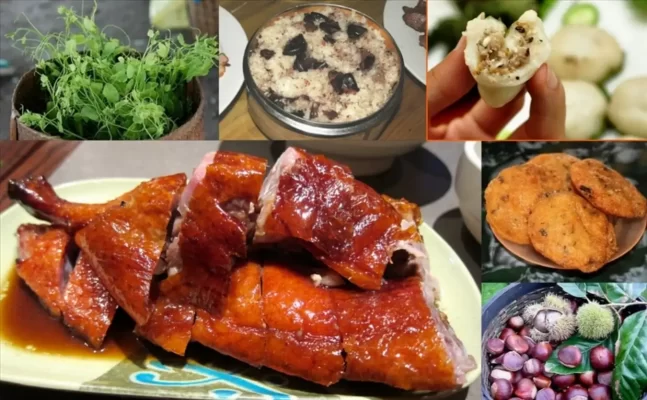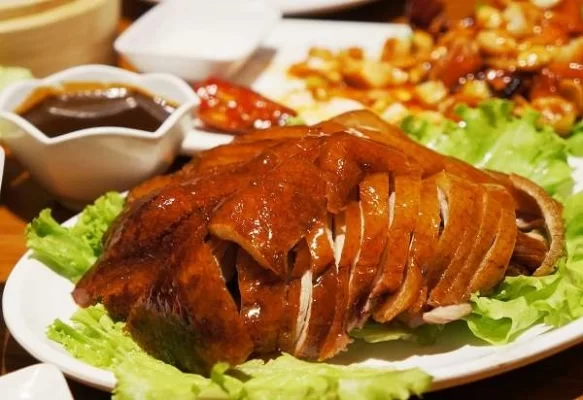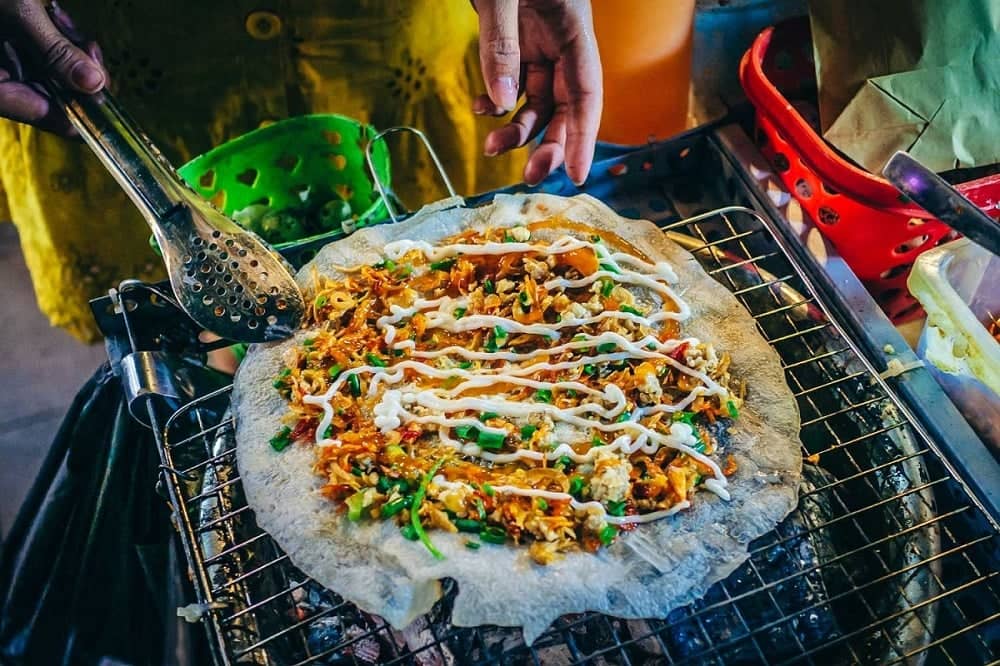
Cao Bang Cuisine
Cao Bang cuisine always attracts domestic and foreign tourists. Cao Bang offers a rich culinary scene with particularly appealing meals in addition to a gorgeous and poetic natural setting. Simple foods infused with tastes from the highland forests and mountains make up Cao Bang delicacies. After eating it, customers are left with a memorable aftertaste. Follow Ula Travel now!
1. The seven-flavor roast duck in Cao Bang cuisine
Many people are familiar with roast duck, but when you discover Cao Bang cuisine, you may taste something quite special called seven-flavor roast duck. Not even the most discriminating palate can resist praising this Cao Bang specialty.

The seven-flavor roast duck
The seven-flavor roast duck, which comes from the Tay ethnic group, is carefully made using a balance of raw and cooked duck meat. Forest honey’s fragrant essence coats the crispy exterior, leaving the meat moist, soft, and luscious.
This dish was traditionally saved for important events like weddings, important festivals, or rituals honoring ancestors. But in the present day, the seven-flavor roast duck has expanded in popularity and is now a staple in many Cao Bang restaurants.
2. Ant egg cakes in Cao Bang cuisine
I’m guessing that when you hear about ant eggs, you picture something really creepy. But in all honesty, everybody who gets the chance to visit this country should try this dish, which is a specialty and incredibly tasty in Cao Bang cuisine. The Tay ethnic group is where ant egg cake originated, and it later reached other ethnic groups in Cao Bang.

Ant egg cakes
You have to travel to Cao Bang in April or May of the solar calendar in order to sample ant egg cakes. Ants reproduce in large numbers during this period so that eggs can be collected for cakes. Sesame leaves encase the cake, which has a layer of soft, flexible sticky rice dough on the outside and fried, flavorful ant eggs filled with pork fat inside. You will taste the ant eggs cracking in your mouth as you eat, along with a very distinct, subtle sweetness.
3. Trung Khanh chestnut in Cao Bang cuisine
One of the outstanding specialties of Cao Bang cuisine is Trung Khanh chestnuts. The fruit known as Trung Khanh chestnut is unique to Cao Bang. The fruit is spherical, uniformly brown, and contains the tiniest seed—the size of a large toe. Its flavor endures whether it is boiled, roasted, dried, or cooked with chicken or hog feet.

Trung Khanh chestnut
Trung Khanh chestnuts have light white fluff, yellow kernels, and a dark brown shell. They are consistently larger than wild chestnuts, often 5-7 times larger. Chestnuts are typically prepared in one of three ways: boiling, grilling over charcoal, or pan-roasting.
They taste deliciously nutty when consumed. To further enhance your health, try making a stew of hog bones and legs with chestnuts. Small traders visit every garden before the district and provincial markets during the chestnut season to purchase goods to sell.
4. Black canarium sticky rice in Cao Bang cuisine
The next specialty in Cao Bang cuisine is black canarium sticky rice. Black canarium should be harvested in September or October, which is late fall. There are numerous delectable recipes that can be made with black canarium, including black canarium sticky rice, black canarium cooked with fish, roasted meat canarium, and meat-stuffed canarium. Among these, black canarium sticky rice is a well-known and well-liked delicacy.

Black canarium sticky rice
In order to make the somewhat intricate dish of black canarium sticky rice, the canarium must first be completely cleaned of all resin with warm water. After that, cover the filling with water, place the pot on the burner, stir, and let the water heat to between 60 and 700 degrees Celsius.
After that, turn off the heat and let the filling soak for one to two hours. Once the filling has softened and cooked through, cut it into half with a knife, remove the seeds from the pulp, and mix with some spice.
There are many delectable varieties of sticky rice in Cao Bang, but we can select the fragrant Bao Lac sticky rice to make sticky rice. The sticky rice tastes even better after it has been cooked and left overnight.
The sticky rice should be washed, soaked for around ten hours, then removed, combined with the black rice vermicelli, and cooked for approximately one hour in a rice cooker. The sticky rice was hot when I opened the lid, and it smelled slightly of sticky rice combined with a rich, creamy aroma. This special dish will make you always remember Cao Bang cuisine even if you only try it once
5. Ap Chao cake in Cao Bang cuisine
People think about Ap Chao cake when they think of Cao Bang cuisine. This is a dish that chases the alpine cold away in no time. It looks like a donut at first glance, but all you need is a container of flour and some basic seasoning in a pan of heated oil. Using each mold to measure out the dough, dip it into the pan of heating oil to truly pique your “craving.”

Ap Chao cakes
When you slice into Ap Chao cake, you’ll find that the dough is crunchy and fragrant, with a gorgeous golden crust. A balanced flavor is created by the rich, sweet taste of duck meat in the filling. The cake tastes great dipped in rich, sweet, and sour fish sauce, along with whatever raw vegetables you like. I guarantee you that when learn about Cao Bang cuisine, you have to have this dish.
6. “Banh Cuon” in Cao Bang cuisine
“Banh cuon” is not unfamiliar to people in the northern region of Vietnam. However, in Cao Bang cuisine, this dish is prepared with a unique recipe. The “banh cuon” in Cao Bang is made from Doan Ket fragrant rice and is crafted on-site using large cast iron pots with wide mouths made of aged bamboo. The filling for the rolls may consist of chicken eggs, minced meat, fried spring rolls, or wood ear mushrooms.

Banh Cuon in Cao Bang
With “banh cuon” in Cao Bang cuisine, instead of eating it with fish sauce like in other regions, locals prefer to enjoy it with a broth simmered from pork bone marrow. When savoring the dish, they often add chili, soaked bamboo shoots, and sweet cicada leaves to enhance the richness and appeal of the broth.
Additionally, the special feature of this dish lies in the “banh cuon” itself. The rice flour used to make the rolls must be the specialty Doan Ket rice, soaked and finely ground to achieve the right level of stickiness and elasticity for the rolling process. The filling for Cao Bang “banh cuon” typically includes sautéed minced meat with wood ear mushrooms or chicken eggs, depending on the diner’s preference.6.
7. Vietnamese nutty ginger sticky rice bars in Cao Bang cuisine
The locals’ favorite cake in Cao Bang cuisine is the Vietnamese sticky rice bars with nutty ginger filling. The major ingredients of the Vietnamese nutty ginger sticky rice bars are roasted glutinous rice flour and roasted peanuts. A small amount of malt is added to the mixture to assist the cake become more elastic. The ginger aroma is also present.

Vietnamese nutty ginger sticky rice bars
All of your problems will vanish if you visit Cao Bang and indulge in some chewy, fragrant Vietnamese nutty ginger sticky rice bars together with a steaming cup of tea. It’s not just tempting to give it a try straight away, but you may purchase it as a gift.
8. Cao Bang sausage in Cao Bang cuisine
The inhabitants of Cao Bang have long loved their sausage, which is a delectable dish that combines the sweet, aromatic taste of beef with the gentle scent of mountain forests and the scent of highland sunshine. Cao Bang Sausage embodies all these characteristics, leaving a genuinely remarkable impression on anyone who has had the pleasure of tasting it when experiencing Cao Bang cuisine.

Cao Bang sausage
The delicious Cao Bang sausage comes from the highland area, where pig farming is common and pigs are free to wander. The Cao Bang cuisine has the unique properties of the highland soil, which sets Cao Bang pigs apart from pigs bred in flatland locations. Furthermore, the distinctive water source, when mixed with different spices, gives the meat and wine from the area a distinct flavor that is regarded as the secret to the success of Cao Bang cuisine.
To make Cao Bang Sausage, uniformly pan-fry or grill it until golden brown, then slice it thinly, dip it in chili sauce, and serve it with cucumbers and fresh herbs or steam-fried for a few minutes to soften it before combining it with fresh garlic chives in a stir-fry. Sausage is eaten as a savory dish with white sticky rice at regular meals.
The deep taste of the country is carried by the smoked flavor of Cao Bang sausage, giving those who eat it a sense of the simplicity and intimacy of Cao Bang cuisine. In spite of its simplicity, it captures the genuine feelings of the people there, making a lasting impression on both locals and visitors to Cao Bang.
9. Nam khau in Cao Bang Cuisine

Nam khau
A unique specialty of Cao Bang cuisine, Nam Khau is well-known for its fascinating name that attracts a lot of people. This dish is also deeply ingrained in Cao Bang culture and is frequently served at important events like Tet festivities or weddings.
The meal is made of slow-cooked pig belly that is prepared in a number of ways, including as boiling, frying, steaming, and using a special spice. Travelers who taste Nam Khau will be rewarded with a rich, fragrant flavor from the special combination of spices and a soft, melt-in-your-mouth meat.
10. Tram Huong fish in Ban Gioc waterfall in Cao Bang cuisine
The fish known as “Tram Huong fish” is a popular specialty of Cao Bang cuisine and can be found at the Ban Gioc waterfall region in Trung Khanh district.
The reason for the name “Tram Huong fish” is that this particular fish frequently consumes the leaves and roots of the sandalwood trees that grow along the Quay Son River in Bac Vong. When eaten, the solid, sweet, and delectable meat of Tram Huong fish releases a faint scent of sandalwood, leaving a lasting memory for travelers.

Tram Huong fish.
Grilling is the greatest way to prepare sandalwood fish since it retains the flavor and even the pickiest eaters will be astonished by the results. After being captured in the river, the fish is cleaned, gutted, and then filled with a variety of seasonings and herbs, like chile, dill, and onions. After that, it is roasted over charcoal while wrapped in banana leaves.



























